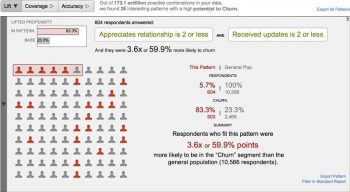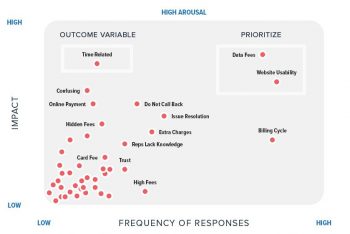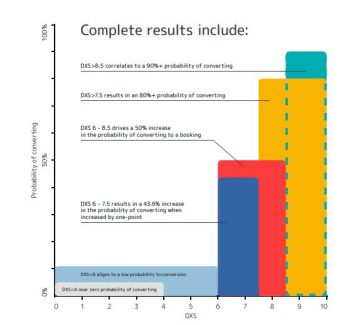
Regular readers of my CX/VoC articles may recall that in 2011 I proposed that Chief Customer Officers needed a “Voice of Customer Command Center” to gain a complete picture of the health of their customer relationships. Since then, it’s clear that more and more attention is being paid to non-survey sources of feedback along with the “digital body language” of customers interacting with CRM, e-commerce, and other systems.
Further, my recent study on Customer Experience Success revealed that just one in four CX initiatives are “Winning” — able to connect the dots from the good work being done to benefits that sponsoring executives care about. Namely: quantified business value or a competitive edge.
As you might expect, Customer Listening is a core practice for any CX program. Unfortunately, many Voice of Customer (VoC) programs are limited to survey-based feedback, which the research found was not a differentiator for Winning programs. Put another way, good for you if you’re doing surveys, but consider it just a first step towards success, not the end game.
This article will explore some examples to help you get out of the survey rut and on the road to lasting CX success.
TELUS Unifies CX Data to Cut Churn and VoC Costs
Canadian telecom firm TELUS is a customer-centric brand that has profited from years of focus on providing outstanding customer experiences as a core business strategy. For the past decade TELUS has consistently promoted “putting customers first“.
As Manager of Customer Experience Research, Stavros Davidovic recounts that in 2016 the company found itself challenged with a common CX problem: many different feedback silos (phone, email, etc.), each with its own way to collect and analyze data. The result was excessive costs and extended response times to customer issues.
Starting from a scan of 20+ vendors, TELUS eventually settled on MaritzCX to help “bring it all together.” A key factor included the ability to integrate and analyze multiple VoC sources, including surveys, text, and 150 fields of operational data. Cultural fit and a proof of concept based on live data also helped seal the deal, says Davidovic.
The results of the CX platform unification have been impressive. A “soft launch” in 2018 found the potential to save about one-third of customers likely to leave based on an analysis of call patterns and technician visits. TELUS also saved money by consolidating VoC platforms, doubled feedback volume, and improved LTR (Likelihood To Recommend), a metric linked to business success.
MaritzCX CEO Michael Sinoway says that while some “just want a VoC program,” better-performing clients think of CX as integrated into the brand’s overall business strategy. In addition to a VoC platform, the firm offers “expert services” to help with CX program design, feedback collection strategies, survey instrument design, and analysis techniques.

Further, Sinoway says that many MaritzCX clients are combining VoC and operational data. Here’s an example of a report from Spotlight® Data Mining, which can analyze data from surveys, uploaded files, and integration with CRM and other enterprise systems, to help indentify customers at risk for churn.
Key point: For CX leadership you’ll need to incorporate non-survey data into VoC analysis and action planning. Take advantage of advanced tools and supporting services from the CX vendor community to make this possible.
FLEETCOR Use Short Surveys to Measure Digital Experience, Drive Action
FLEETCOR offers payment solutions to help businesses manage fuel and other expenses. Years of growth by acquistion (76 and counting!), while great for the top line, resulted in a disjointed approach to CX.
The wake-up call came a couple of years ago when a PR problem about customer fees hit the stock, says Jenn Oyler, FLEETCOR’s Global Vice President Customer Experience and Research. An investigation of the underlying causes revealed the downside of all those acquisitions — developing a complete picture of any customer could require interrogating a half dozen different systems. To make matters worse, information wasn’t shared between various organization silos, resulting in poor service when customers called.
Oyler used a “CX accelerator” program to engage with executives across the organization. Early on, she knew that it was critical to find the right metrics and VoC approach to help identify and prioritize myriad problems. And fast!
While traditional customer feedback surveys had been a staple of her past CX work, Oyler decided to use the Decooda CX I.Q.® platform instead. This approach is based on one quantitative rating question (CSAT or NPS) supplemented with an open-ended “Imaginative Question (I.Q.)” that enabled customers to express feedback in their own words. The resulting insights helped FLEETCOR dig deeper than obvious complaints about fees to solve more critical underlying problems requiring new systems.

The concept of one question plus an open-ended comment dates back to the introduction of the Net Promoter Score. The problem is that enterprises need to know what action is needed, which typically meant adding a bunch more questions. By contrast, Decooda’s approach uses advanced analytics to literally “decode” the meaning of the text submitted to the “I.Q.” question to reveal key issues and impact. This chart illustrates that sometimes the issues with higher frequency are not necessarily the top priority for action.
Decooda founder/CEO David Johnson launched the firm in 2010 to try to solve the problem of lengthy surveys and declining response rates. The customer’s answer to a simple question like “tell us about your experience” is analyzed to identify issues and emotions. Decooda’s “Impact Analysis” is an AI-based algorithm that figure out what customers are talking about and what impacts their behavior, so that the right actions can be prioritized.
Based on my CX study, the majority of CX pros are stuck in a kind of whack-a-mole situation, with an endless number of issues to work on. Without the right intelligence, the most frequently mentioned issues will get attention. For example, says Johnson, razor consumers may complain about the buying process or packaging, but fixing these problems has no “cognitive impact” and doesn’t improve CX.
Key point: Take advantage of unstructured text and the latest analysis tools to cut down surveys and still get actionable insights.
TUI Maximizes Impact of Digital Experience Improvements
Searching for a high-end holiday in Europe might well take you to UK-based travel company TUI. The website touts TUI’s “handpicked hotels” and “tailor-made experiences” along with the usual bookings of hotels, flights, and cruises.
Starting with a small team 10 years ago, TUI now has over 20 analysts devoted to the digital customer experience, according to Hirra Sulanki, Head of Digital Analytics. The goal is to replicate the travel agent experience online, where attention spans are short and the options are many. For starters, the site needs to give a quick response — under three seconds ideally. From there, it gets much more complicated due to the wide range of options available.
The goal: Where to focus scarce resources to ensure a flawless, friction-free experience that increases bookings?
Sulanki says they turned to Decibel to quantify 100% of online experiences with a Digital Experience Score (DXS), pinpoint problems needing attention, and show the business impact of changes. For example, while customers might complain about site navigation in a pop-up survey, Decibel’s analytics helped draw attention to troublesome forms that created frustration due to confusing instructions. A minor tweak improved bookings and decreased calls for help in the contact center.

Decibel was founded five years ago by Ben Harris, who had more than a decade of agency experience helping clients improve web sites and apps. He observed that traditional web analytics “click data” wasn’t giving the complete picture, so a new solution was developed to understand how users were interacting within a page, including scrolling, directional changes, and more. All this aggregated into a score (DXS) that could be tied to business outcomes like conversions and bookings.
TUI was ultimately able to quantify the impact of improving digital experiences. According to Sulanki, improving DXS from 5 to 6 could result in over £20 million in annual revenue. That’s the kind of help many CX professionals need to get the attention of top management.
Key point: As more customer interactions shift online, use the proper tools to find and fix points of friction and frustration.
Where to Look for Help
The tech industry is working hard to improve the VoC tools needed to handle a growing and diverse set of non-survey sources. Odds are your company is awash in digital information, but it’s not linked to customer satisfaction data captured in surveys or text/speech analytics.
In addition to the tech providers mentioned in the article, ask your current survey vendor if they can incorporate non-survey data in their platform. Most of the enterprise-focused EFM vendors now offer capabilities in this area.
Keep an open mind about new solutions specifically designed for digital and multi-channel feedback analysis. For example, Topbox is a young company that decided to major on the aggregation and analytics problem, to focus resources on the most important issues.
The real key to success is to work backward from the insight you need to drive right actions. Actions that will improve the customer’s experience and create the business value you’ll need to make those CX investments. That will lead you to the data sources which will suggest tools and platforms that can help.
Further Reading and Resources
- Customer Experience at a Crossroads: What Drives CX Success?
- Voice of Customer Industry Trends: Consolidation, Disruption, and the Rise of Real-Time Action
- iCXM Comes of Age — Using AI to Know, Engage, and Serve Your Customers Better
- The Next-Generation Voice of Customer Command Center: Tool Time for Chief Customer Officers
Disclosure: Examples in this article were drawn from discussions I’ve had with vendors who reached out to me in the past few months with briefing requests. They are not necessarily representative of all the industry activity nor should vendor mentions be considered an endorsement. Some vendors have been sponsors of CustomerThink.



